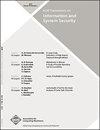Combining fragmentation and encryption to protect privacy in data storage
Q Engineering
ACM Transactions on Information and System Security
Pub Date : 2010-07-01
DOI:10.1145/1805974.1805978
引用次数: 232
Abstract
The impact of privacy requirements in the development of modern applications is increasing very quickly. Many commercial and legal regulations are driving the need to develop reliable solutions for protecting sensitive information whenever it is stored, processed, or communicated to external parties. To this purpose, encryption techniques are currently used in many scenarios where data protection is required since they provide a layer of protection against the disclosure of personal information, which safeguards companies from the costs that may arise from exposing their data to privacy breaches. However, dealing with encrypted data may make query processing more expensive. In this article, we address these issues by proposing a solution to enforce the privacy of data collections that combines data fragmentation with encryption. We model privacy requirements as confidentiality constraints expressing the sensitivity of attributes and their associations. We then use encryption as an underlying (conveniently available) measure for making data unintelligible while exploiting fragmentation as a way to break sensitive associations among attributes. We formalize the problem of minimizing the impact of fragmentation in terms of number of fragments and their affinity and present two heuristic algorithms for solving such problems. We also discuss experimental results, comparing the solutions returned by our heuristics with respect to optimal solutions, which show that the heuristics, while guaranteeing a polynomial-time computation cost are able to retrieve solutions close to optimum.将分片和加密相结合,保护数据存储中的隐私
在现代应用程序的开发中,隐私需求的影响正在迅速增加。许多商业和法律法规促使人们需要开发可靠的解决方案,以便在存储、处理或与外部方通信时保护敏感信息。为此目的,加密技术目前在许多需要数据保护的场景中使用,因为它们提供了一层防止个人信息泄露的保护,从而保护公司免受因将数据暴露给隐私泄露而可能产生的成本。但是,处理加密数据可能会使查询处理的成本更高。在本文中,我们通过提出一种解决方案来解决这些问题,该解决方案将数据碎片与加密相结合,以加强数据集合的隐私性。我们将隐私需求建模为表示属性及其关联敏感性的机密性约束。然后,我们使用加密作为底层(方便使用)措施,使数据难以理解,同时利用碎片作为打破属性之间敏感关联的方法。我们根据碎片的数量和它们的亲和力形式化了最小化碎片影响的问题,并提出了两种启发式算法来解决这类问题。我们还讨论了实验结果,将我们的启发式方法返回的解与最优解进行了比较,结果表明,在保证多项式时间计算成本的情况下,启发式方法能够检索到接近最优解。
本文章由计算机程序翻译,如有差异,请以英文原文为准。
求助全文
约1分钟内获得全文
求助全文
来源期刊

ACM Transactions on Information and System Security
工程技术-计算机:信息系统
CiteScore
4.50
自引率
0.00%
发文量
0
审稿时长
3.3 months
期刊介绍:
ISSEC is a scholarly, scientific journal that publishes original research papers in all areas of information and system security, including technologies, systems, applications, and policies.
 求助内容:
求助内容: 应助结果提醒方式:
应助结果提醒方式:


